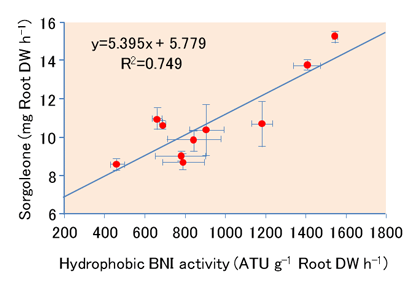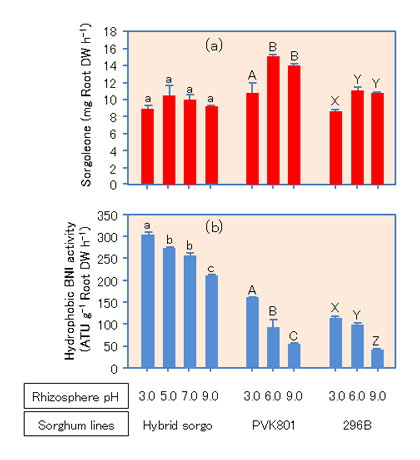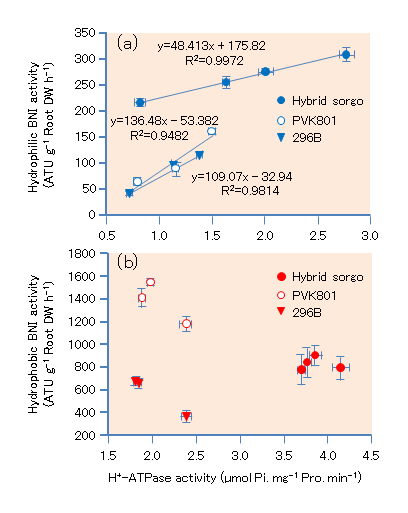Further insights into underlying mechanisms for the release of biological nitrification inhibitors from sorghum roots
Description
Sorghum roots release two categories of biological nitrification inhibitors (BNIs) – hydrophilic-BNIs and hydrophobic-BNIs. Earlier research indicated that rhizosphere pH and plasma membrane (PM) H+-ATPase are functionally linked with the release of hydrophilic BNIs but the underlying mechanisms are not fully elucidated. It was earlier hypothesized that BNIs are transported through anion channels but has not been confirmed. This study is designed to reveal further insights into the regulatory mechanisms of BNI release in root systems using three sorghum genetic stocks. The findings are as follows:
- The levels of sorgoleone (a hydrophobic inhibitor) in root dichloromethane (DCM) wash are positively correlated (Fig. 1).
- A decrease in rhizosphere pH improved the release of hydrophilic-BNIs from the roots of all three sorghum genotypes but had no effect on the release of hydrophobic-BNIs (Fig. 2).
- Fusicoccin, a stimulator of PM H+ ATPase phosphorylation, promoted H+ extrusion and stimulated the release of hydrophilic-BNIs. Vanadate, an inhibitor of PM H+ ATPase phosphorylation, in contrast, suppressed H+ extrusion and lowered the release of hydrophilic-BNIs.
- The release of hydrophilic-BNIs is positively linked with PM H+-ATPase activity levels in sorghum roots (Fig. 3a). However, statistical analysis indicates no relationship between PM H+ ATPase and hydrophobic-BNI release in sorghum root systems (Fig. 3b).
- Anion-channel blockers did not inhibit the release of hydrophilic BNIs, but enhanced H+-extrusion and hydrophilic-BNIs release. These results indicate that some unknown membrane transporters are operating the release of protonated BNIs, which may compensate for charge balance when transport of other anions is suppressed.
Sorgoleone release from root systems contributes to about 50% of the BNI potential in sorghum roots. The pH insensitivity for sorgoleone release will have implications for BNI-trait expression in soil types with low buffering capacity. Genetic improvements in sorgoleone release can thus result in future sorghum varieties with high-BNI capacity in root systems where the trait is expressed in a range of soil types with varying pH, thus can have wider adaptation to low-N production environments with improvements in agronomic nitrogen use efficiency (NUE).
Figure, table
-
Fig. 1. Relationship between hydrophobic-BNI activity and sorgoleone levels
-
Fig. 2. Rhizosphere pH influence on the release of sorgoleone (a) and hydrophilic nitrification inhibitors (b) from sorghum roots, respectively
-
Fig. 3. Relationship between PM H+-ATPase activity and hydrophilic (a) or hydrophobic (b) BNI activity, respectively, in root systems of sorghum
- Program name
- Term of research
-
FY2017 (2011~2015)
- Responsible researcher
-
Subbarao Guntur Venkata ( Crop, Livestock and Environment Division )
ORCID ID0000-0002-7243-6394KAKEN Researcher No.: 00442723Yoshihashi Tadashi ( Crop, Livestock and Environment Division )
T. Di ( Nanjing Agricultural University )
Afzal M. R. ( Nanjing Agricultural University )
Zhu Y. ( Nanjing Agricultural University )
Deshpande Santosh ( International Crops Research Institute for the Semi-Arid Tropics )
- ほか
- Publication, etc.
-
https://doi.org/10.1007/s11104-017-3505-5
Di T et al. (2017) Plant and Soil
- Japanese PDF
-
A4 323.95 KB
A3 278.56 KB
- English PDF
-
A4 167.29 KB
A3 178.77 KB
- Poster PDF
-
2017_A04_poster.pdf447.18 KB



